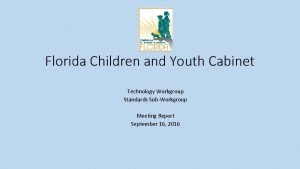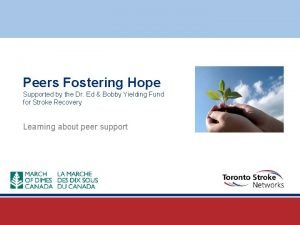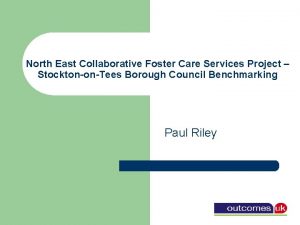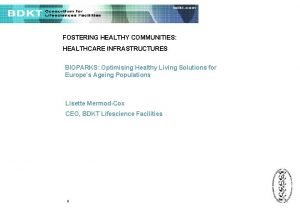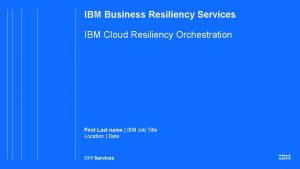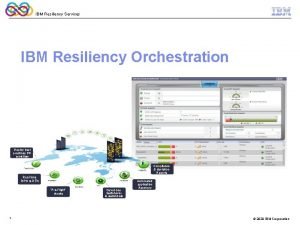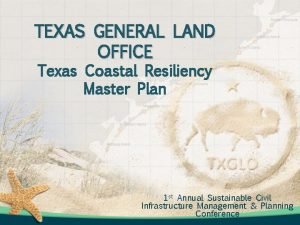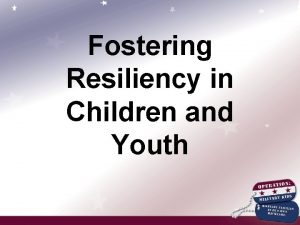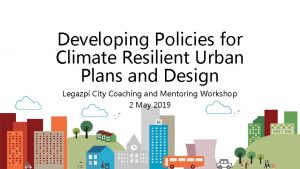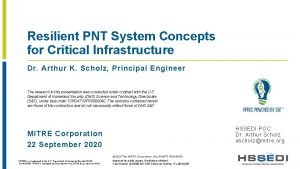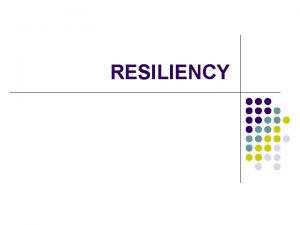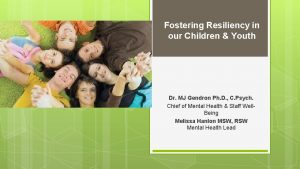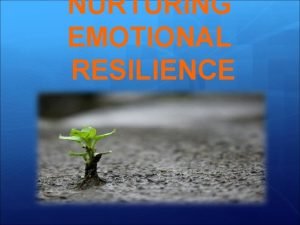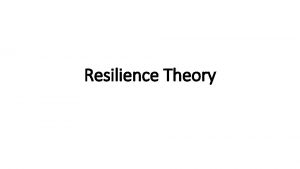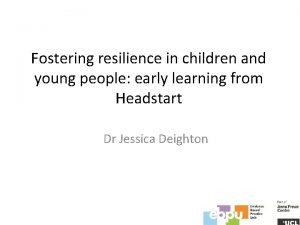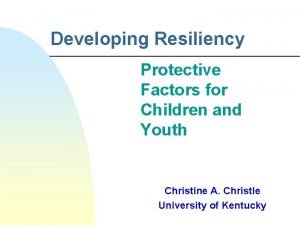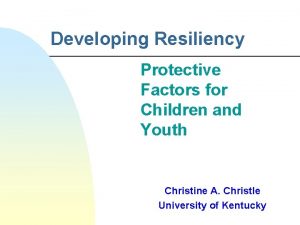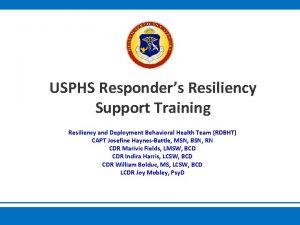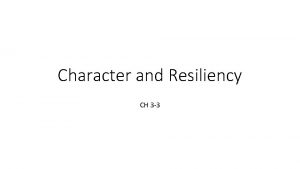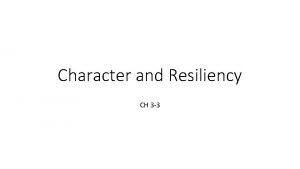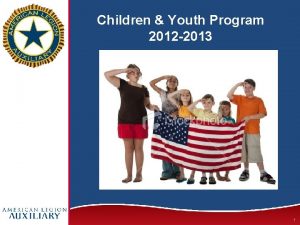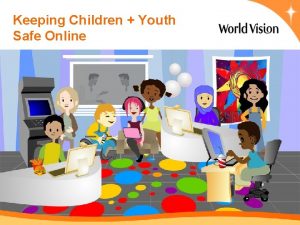Fostering Resiliency in Children and Youth Resilience Shifting



















- Slides: 19

Fostering Resiliency in Children and Youth

Resilience: Shifting Paradigms • From • To • Risk • Resilience • Problem Solving • Positive Development • Pathology • Wellness • Reactive • Proactive • Deficiency • Competition • Collaboration • People as Problems • People as Resources • Authoritarian • Democratic • Remedial • Empowerment

Understanding Risk Factors ------------ • Those conditions, attitudes, and behaviors that occur around and within communities, families, schools, teens, and their friends that increase the likelihood that individuals will have difficulty with school/work, the law, alcohol, and other drugs, violence, and abuse. From: Together We Can by Gibbs and Bennett • What risk factors are present in the lives of children or youth dealing with the deployment of a parent or loved one?

Definitions of Resilience • The capacity to spring back, rebound, successfully adapt in the face of adversity, and develop social, academic, and vocational competence despite exposure to severe stress or simply the stress that is inherent in today’s world. Nan Henderson, MSW • The capacity to rise above adversity and to forge lasting strengths in the struggle. It is the means by which children/adults can rebound from hardship and emerge as strong, healthy individuals, able to lead gratifying lives, albeit with some scars to show for their experiences. Stephen and Sybil Wolin

How do Military Kids Demonstrate their Resilience?

Profile of Resilient Individual • Social Competence • • Responsiveness Flexibility Empathy Caring Communication skills Sense of humor Other pro-social behavior • Problem Solving • Ability to think abstractly, reflectively, and flexibly • Ability to attempt alternative solutions for both cognitive and social problems

Profile of A Resilient Individual • Sense of Purpose • Healthy expectancies Strong sense of independence • Goal-directedness Internal locus of • Success/achievement control orientation Sense of personal • Persistence power, self-esteem, • Hopefulness and self-efficacy • Hardiness Self-discipline • Sense of anticipation Impulse control and compelling Ability to separate self future from environment • Autonomy • • •

Protective Factors • Definition: Conditions that buffer people from the negative consequences of exposure to risks by either reducing the impact of risks or changing the way a person responds to the risk by promoting positive behavior, health, well-being, and personal success. David Hawkins and Richard Catalano

The 40 Developmental Assets ----------- • External Assets – Support – Empowerment – Boundaries and Expectations – Constructive Use of Time • Internal Assets – Commitment to Learning – Positive Values – Social Competencies – Positive Identity

Working Together: Protective Factors and Developmental Assets

Ingredients of Resilience: 7 Crucial C’s (Dr. Ken Ginsburg) • Competence – Ability or know how to effectively handle situations • Confidence – Solid belief’s in ones abilities • Connection – Close ties to family, friends, school, community that produce strong values and prevent self destructive behaviors • Character – Fundamental sense of right and wrong to ensure youth are prepared to make wise choices, contribute to world, and become stable adults

Ingredients of Resilience: 7 Crucial C’s (Dr. Ken Ginsburg) • Contribution – When youth realize the world is a better place because they are in it and contributing to it • Coping – A wide repertoire of positive, adaptive coping strategies • Control – When youth realize they can control the outcomes of their decisions and actions

Four Steps to Fostering Resilience • Step One—Always communicate the “resiliency attitude” • Step Two—Focus on strengths with same or even greater meticulousness than used in characterizing weaknesses • Step Three—Build “Resiliency Wheel/Web” around each child/youth • Step Four— “Never Give Up!” Attitude

Step One in Fostering Resilience: Always Communicate the “Resiliency Attitude” • Expressed verbally and nonverbally. • “I see what is right with you no matter what has happened in the past, no matter what challenges/problems you face right now. ” • How can we communicate the “resiliency attitude” to children and youth we encounter who may be struggling with the deployment of a parent or loved one?

Step Two in Fostering Resilience: Focus on strengths with same or even greater meticulousness than used in characterizing weaknesses. • Honestly acknowledging problems/challenges. • And…focus more prominently on individual strengths and positive supports! (Reframing) • How can we build on strengths of children and youth dealing with deployment of parent or loved one?

Step Three in Fostering Resilience: The Resiliency Wheel

Step Four in Fostering Resilience: Never Give Up! attitude • Resiliency is a lifespan process that ebbs and flows. • Resiliency doesn’t happen by putting a kid through a program. • Connection(s) with caring adults with high expectations and who offer opportunities for involvement create resilient children • How can we present a “Never Give Up!” attitude to children and youth dealing with the deployment of a parent or loved one?

Fostering Resilience Means. . . • *Care and Support • *High Expectations • *Opportunities for Involvement

Discussion Questions • How can we work together as a team to foster resilience in youth by… • Communicating the resiliency attitude? • Focusing on strengths? • Working toward building a wheel/web of support? • Demonstrating a “Never-Give-Up” attitude? • How can we foster our own resilience as teams to stay enthusiastic, motivated, healthy and well?
 Creativity and play fostering creativity
Creativity and play fostering creativity Fostering teamwork
Fostering teamwork Florida children and youth cabinet
Florida children and youth cabinet Fostering hope scholarship
Fostering hope scholarship Fostering stockton on tees
Fostering stockton on tees Fostering healthy solutions
Fostering healthy solutions Fostering in doncaster
Fostering in doncaster Bcrs business continuity
Bcrs business continuity Ibm every second counts
Ibm every second counts Ibm resiliency orchestrator
Ibm resiliency orchestrator Ibm geographically dispersed resiliency for power systems
Ibm geographically dispersed resiliency for power systems Ibm geographically dispersed resiliency for power systems
Ibm geographically dispersed resiliency for power systems Sgip equity resiliency program
Sgip equity resiliency program Texas glo gis
Texas glo gis Protective factors definition
Protective factors definition Calactite
Calactite Resiliency
Resiliency Difference between shifting cultivation and taungya system
Difference between shifting cultivation and taungya system Chen
Chen Shifting vs springing executory interest
Shifting vs springing executory interest


